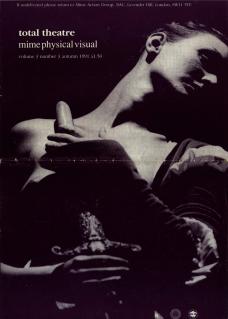‘Dance at the moment is in the doldrums,’ said Alistair Macauly, the Financial Times international dance critic in conversation only last month. Regarding Europe he continued, ‘people are saying “things” are happening in Italy and France but they're not; there is money but nothing new’.
This observation could be either a reference to a confused transition in dance's development coming after the many changes that occurred in the 1980s or a sad indictment of that decade. Dance, especially in the contemporary field, will retreat into its infrastructure for the answers; whereas Mime, not possessing such back-up, will continue to be ignored.
In the late 1970s and early 1980s the infrastructure for the trained contemporary dancer was as follows. The pinnacle was to be employed by London Contemporary Dance Theatre (which sadly recruited only from its own school) or the regional companies, Basic Space in Edinburgh (now defunct), Spiral based in Liverpool, and Jumpers (now Diversions) in Cardiff. There were also more innovative companies such as Extemporary and Ian Spink's Second Stride both based in London. These companies gave rise to what became known in the mid-eighties as ‘New Dance’ with new groups emerging that comprised mainly of students having just graduated from the contemporary dance schools. These groups tended to remain in the capital and have exquisite names such as The Cholmondeleys (pronounced Chumleys), Geographical Duvet (folded 1990), Adventures in Motion Pictures, and Lloyd Newson's DV8. These later were grouped with other movement based groups and the term ‘Physical Theatre’ was born.
Mime influenced contemporary film, TV, theatre and street theatre in the eighties, but, because of very limited specialist training available mime would undergo assimilation and be obscured. There were and are no mime schools on the scale of dance schools. Drama schools ‘cover’ mime and that's it. Mimes in the United Kingdom therefore have tended to come from varied backgrounds. American, David Glass, originally trained at London Contemporary Dance School, New Zealander, Nola Rae, trained at the Royal Ballet School, and Trestle originated from John Wright's tutorship at Middlesex Polytechnic.
In the early eighties groups that had been trained in this country would have studied with Desmond Jones (Intriplicate, Trickster) or Ronald Wilson (The Mivi Mime Company and solo mime John Mowat). The rest tended to have to go abroad for training and from the Lecoq school came Moving Picture Mime Show, Theatre de Complicité, and more recently Talking Pictures.
There was fine theatre produced but still no real structured base formed, although mime training was possible and being funded. The British Summer Schools of Mime Theatre were short intensive courses with high-calibre artists-in-residence. Jacques Lecoq, Mike Alfreds and Theatre du Mouvement were employed by the Arts Council to widen mime's horizons. However, the policy of integrating artists from various disciplines for the betterment of one area is open to question; it might have obscured it because of who attended, what was taught, and to what specific areas the knowledge would go.
The problem of mime as always is people's perception of it, its limitations or lack of them. Its strength is also its weakness, it can be used, borrowed and abused depending upon one's prejudice against alternative cabaret artists like Vic Reeves. The word mime now conjures up horror, it is one of the reasons Mime Theatre Project likes to be referred to as MTP and a ‘mime’ magazine is called ‘Total Theatre’. Successful mimes who have started directing are now called theatre directors not mime directors. Mollie Guilfoyle (Intriplicate) now directs movement theatre integrating it with sign language. David Glass uses his name for his own sake and profile in the ‘David Glass New Mime Ensemble’. Guilfoyle's innovations are a product of the late 1980s dance direction of working with people with disabilities, in this case hearing impairment, but once again mime will get little credit whatsoever.
There have been success stories. Thunderbirds F.A.B., originally Mime Theatre Project's early 1980s parody of the television series, is increasing mime accessibility with runs in the West End (Apollo Theatre 1989-90) and presently at the Mermaid. Emerging companies like Talking Pictures have regional funding from Northern Arts and are Artists-in-Residence at the Crewe and Alsager College. They are also intelligent enough to steer clear of the common mistake made by dance companies of directing themselves and have used experienced director Mike Alfreds to create their show Trouble In Paradise. Pierre Byland has agreed to direct their next offering with the employment of other performers so that the real potential within the company can be realised. The name of the company reflects what its about and does not confuse. In dance the Cholmondeleys, for example, had difficulties with booking agents because of the confusing pronunciation of their name.
To conclude I must return to the infrastructural fabric of what is needed in mime. Mime Animateurs, a precedent set by pioneer Pat Keysel in 1982 and followed later by Lesley Moss in Coventry are important. Dance and Mime Officers tend to be dancers with little mime knowledge, no matter how well intentioned. With the demise of Second Stride and Extemporary the Arts Council has just funded five new dance agencies to promote dance in the regions. Mime should not be alienated from the wide regional infrastructure these agencies will build and hopefully by the end of the next decade we will see mime get its just and proper recognition.


